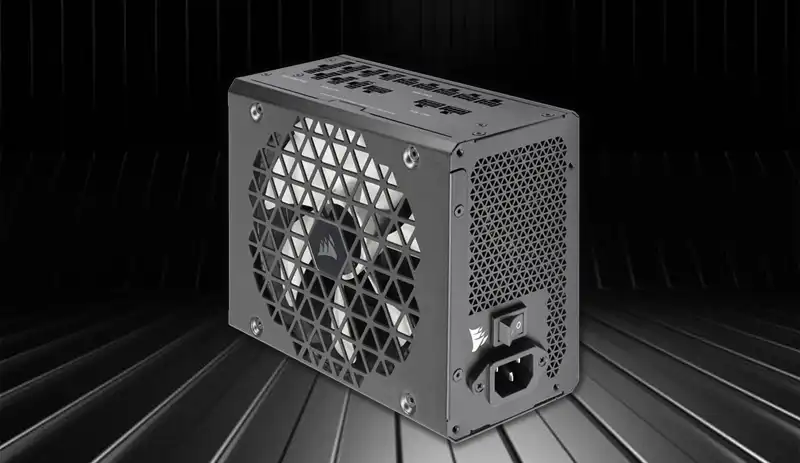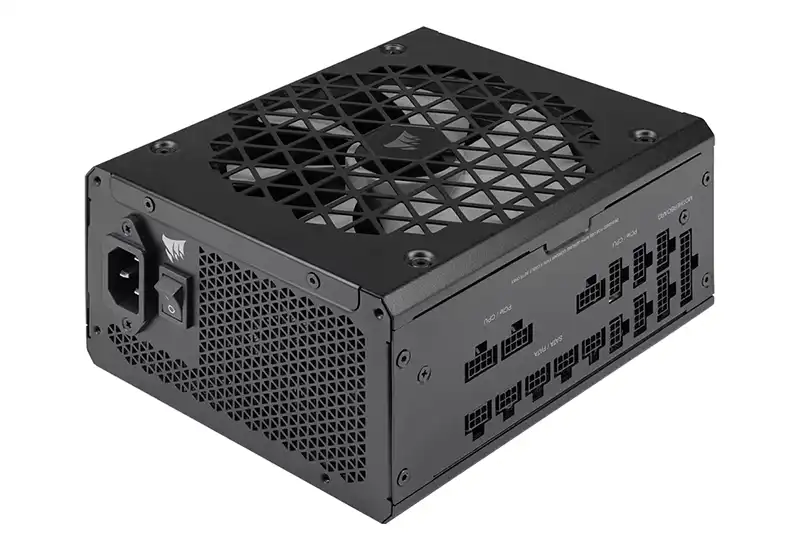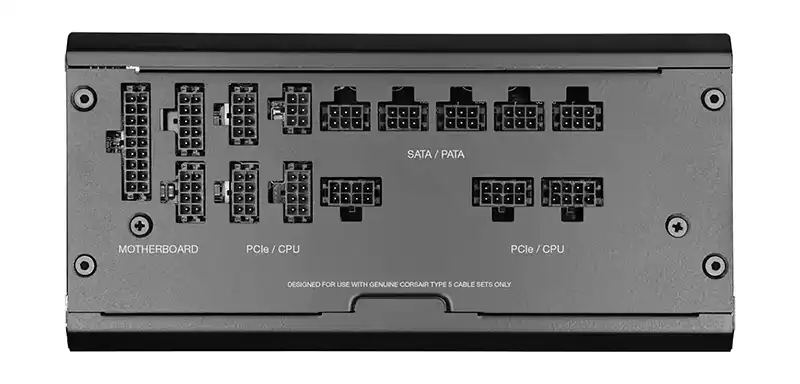You can also be interested in these:
- Corsair AF120 RGB Elite full review
- Corsair iCUE H150i ELITE LCD XT full review
- Corsair Dominator Platinum RGB DDR5 review
- Corsair Vengeance RGB RT Review
In this review, we will be analyzing the new high-performance power supply series, the Corsair RM1000x Shift, which is the second most powerful model of the four available versions. In this series, there are some new features such as the side-mounted connection panel, which is compatible with chassis up to 210mm in width, a zero RPM fan system, and a single rail capable of supplying up to 600W through the new 12VHPWR connector, which is also included. The internal quality is guaranteed with 100% Japanese capacitors at 105°C.

External design
Regarding the external design of the Corsair RM1000x Shift, the main novelty compared to the previous version is the location of the port panel on the right-hand side. This side is usually placed in the cable storage area or at the top in case of vertical installation in chassis like the Corsair Crystal 680X. Dimensions are another important aspect of its design, since at 180mm in length, the chassis capacity must be considered in the case of a compact one. We have verified the compatibility of the lateral port panel with a 220mm ATX chassis, and the result is satisfactory.
The air intake area features a 140mm fan with white blades and a triangular patterned grille that provides an aesthetic quality. However, this grille will clearly be a perfect dust entry point in poorly insulated chassis. The cut corner detail improves the compact feel of the power supply, although it does not offer any advantages in terms of space.

The area where the ports are normally located is completely smooth, and there are two screws on each side that hold half of the power supply cover. One of these screws has the warranty seal, which means that if the power supply is opened, the warranty will be invalidated. At the top, there is a sticker that describes the operation of the rails and the quality certifications, as usual.
We conclude this section with the rear panel, which is the same as that of any other power supply, with a wide grille area to expel hot air, a 100-230V 3-pin power input, and a manual power switch.
Connection panel
We now move on to the internal connection panel located on the side, which in the Corsair RM1000x Shift model has a total of 14 outputs if we count the two corresponding to the ATX connector as one. The different areas indicate their function through white text. In total, there are 7 outputs of 8 pins for PCIe and CPU connectors, 6 outputs for SATA and MOLEX connectors, and 2 outputs for the ATX connector.

It is important to highlight that these headers significantly reduce their size compared to standard headers on other power supplies. To achieve this, Corsair uses Type 5 Gen 1 micro-fit cables, and compatibility is clearly indicated in the printed text. The aim of reducing the size is to take up less lateral space and make it easier for users to install.
Focusing on the cabling, a total of 15 units are included, which means that there will be some left over if the entire panel is completed. To explain the highlighted features of each one, we will group them by type:
- The 12VHPWR cable has a length of 650 mm and will easily cover the distance to the GPU, even in Full Tower chassis. This cable has 16AWG conductors, which is normal, and is capable of supporting up to 600W of sustained power and 3 times higher peaks, as per the Intel ATX 3.0 standard on the PCIe 5.0 platform.
- As for the PCIe cables, those with a single header have a 16AWG gauge, while those with two reduce the section to 18AWG on the stretch to the second header. Both CPU cables have an 18AWG gauge and measure 650 mm.
- Finally, all SATA and MOLEX cables have an 18AWG gauge, which is sufficient to power less demanding components. If we add up the full capacity of the supply with its 6 outputs, we could add up to 25 connections, although the connectors are very close together. Instead of being separated by 150 mm, they are only separated by 115 mm and 100 mm.
It is important to mention that FDD headers are no longer included, as they are practically obsolete.
Internal components
Moving on to the internal components, access to the inside of the Corsair RM1000x Shift is obtained by removing 4 hexagonal head screws, two located at each end of the supply. Corsair provides a 10-year warranty for all of its power supplies.
Corsair relies on CWT as the manufacturer for the platform that brings its new power supplies to life. A full bridge topology is used with a resonant LLC converter on the primary side and synchronous rectifiers with DC-DC converters on the secondary side. This is a modern configuration that provides a clean and steady signal, with more efficient resting points.
The PCB used will be common for the 1000W and 1200W variants, as specified on the surface. It is revision D01 (the initial one) with double-sided elements. In addition, we have multiple expansion boards on the main one, such as the 5VSB rail, PWM control, or the connection panel itself.
Regarding the protections, this power supply has OCP, OVP, OPP, OTP, and SCP, with a Weltrend WT7502R supervisor circuit. It also includes the EMI/EMC transient filter, which incorporates an NTC SCK20150 thermistor, followed by a relay located in the opposite corner.
Next to the EMI/EMC transient filter, we find the full bridge AC/DC rectifier, attached to an aluminum heatsink, and a vertical PFC MOS (Power Factor Correction) board with control diodes and the associated coil just behind it. In the main elements, we obviously find aluminum heatsinks that keep the transistor temperatures under control.
The Corsair RM1000x Shift has two main capacitors on the primary side from Nippon Chemi-Con: one of 650µF and another of 470µF, both rated at 105°C and 2,000h. These will be accompanied by 4 Infineon IPA60R190P6 switches of 12.7A and 3 Infineon IPA60R125P6 MOSFETS of 16A.
On the 12V secondary side, we find 6 appropriately cooled Infineon BSC014N06NS MOSFETS of 152A, along with a series of filtering capacitors, all from Nichicon and Nippon Chemi-con. It is important to note that all capacitors are Japanese and from top brands, and that the quality of their MOSFETS is excellent.
Fan
As for the fan, a 140mm Corsair NR140P with fluid-dynamic bearing and PWM control through an On-Bright OB2365T circuit has been equipped. This has a zero RPM system, which means that the fan will remain off until the load reaches 50% capacity.
Conclusion on Corsair RM1000x Shift
We can say without a doubt that this Corsair power supply demonstrates high performance, with a rather original approach in terms of connectors and placement. However, it is surprising that it has remained at 80+ Gold certification instead of achieving at least Platinum certification, since there are competitors that offer a slight advantage in this aspect.
The quality of the components used is undeniable, which leads us to state that we are facing one of the best single rail platforms, capable of supplying up to 600W on the 12VHPWR connection, with Intel ATX 3.0 certification. It has 100% Japanese high-resistance capacitors and Infineon MOSFETS, a perfect combination to ensure reliability. The zero RPM cooling system is a great advantage, as up to 500W the power supply will not generate noise, and when it is active, the noise level is low.
As for the external design, it is undeniable that it is original with its 100% modular panel on the side, but it is important to note that at least 25 mm of free space is required for the headers, and that it is a rather large power supply, so it could be a problem in thin and small cases. The cables are of good quality, although a bit rigid, but they fit the expected gauges.
The price of this Corsair RM1000x Shift is $242 USD, while the rest of the models are priced at $180 USD for the 750W model, $200 USD for the 850W model, and $280 USD for the 1200W model, which shares the same platform as the analyzed model. Although it is a slightly higher price compared to the competition, in terms of quality, it is excellent.
More stories like this
- Corsair AF120 RGB Elite full review
- Corsair iCUE H150i ELITE LCD XT full review
- Corsair Dominator Platinum RGB DDR5 review
- Corsair Vengeance RGB RT Review
- Corsair M65 RGB Ultra Wireless gaming mouse
- Corsair HS65 Wireless headset full review